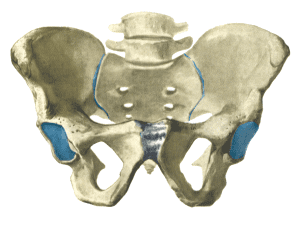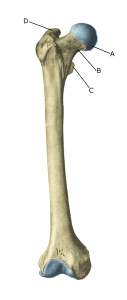Anatomy
 The femur and pelvis, as well as the sacrum (and small coccyx) make up the bones of the hip region.
The femur and pelvis, as well as the sacrum (and small coccyx) make up the bones of the hip region.
 Pelvis and femur from the front:
Pelvis and femur from the front:
A. Caput femoris
B. Collum femoris
C. Trochanter minor
D. Trochanter major
Cause
Repetitive strain, especially when walking, running and jumping, can cause cracks (fatigue fractures) in all bones, with the pubic bone (os pubis) and femoral neck (collum femoris) being the bones where fatigue fractures are most common. The risk is increased by inadequate cushioning in running shoes and too rapid an increase in training intensity,
Eating disorders and lack of menstruation (amenorrhoea) increase the risk of fatigue fractures up to 13 times in teenagers. Low bone mineral density (BMD) increases the risk of fatigue fractures 4.5 times (Nose-Ogura S, et al. 2019).
Symptoms
Hip/groin pain on pressure (direct and indirect tenderness) and on exertion (walking, running, jumping). The pain is initially mild and diffuse after exertion, but gradually worsens and the athlete eventually has to stop physical activity.
Examination
Fatigue fractures should always be suspected if there is pain when weight is placed on the leg and the pain is persistent. X-rays are the primary examination, but cannot detect the fatigue fracture early on, so X-rays should be repeated after a few weeks if a fatigue fracture is still suspected. CT, MRI and ultrasound scans can often diagnose fatigue fractures much earlier than X-ray,
See ultrasound of fatigue fracture
Making the diagnosis as early as possible is crucial to the outcome of treatment.
Treatment
Treatment primarily includes relief from pain-inducing activity and graduated rehabilitation within the pain threshold. In some cases, surgery is necessary, especially in the femoral neck (Bernstein EM, et al. 2022).
Complications
If the progress is not smooth, you should be re-evaluated by your doctor to ensure that the fracture is healing as planned. In some cases, a false joint may form (pseudoarthrosis), which will require surgical treatment.
